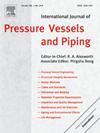Crack arrest analysis of dense-phase CO2 pipelines reinforced with CFRP wraps using a coupled fluid–structure–damage model
IF 3.5
2区 工程技术
Q2 ENGINEERING, MECHANICAL
International Journal of Pressure Vessels and Piping
Pub Date : 2025-07-23
DOI:10.1016/j.ijpvp.2025.105610
引用次数: 0
Abstract
Carbon capture, utilization, and storage (CCUS) technologies are widely regarded as critical pathways toward achieving carbon peaking and carbon neutrality goals, where the pipeline transportation of CO2 plays a pivotal role. Due to the extended decompression plateau of CO2 in dense-phase or supercritical states, pipeline rupture events can lead to rapid crack propagation because the crack tip pressure cannot be relieved promptly, potentially triggering long-range ductile fracture (RDF) accidents. Therefore, investigating crack propagation control and arrest technologies for CO2 pipelines holds significant engineering value. In this study, the effectiveness of carbon fiber composite crack arrestors in mitigating crack propagation in dense-phase CO2 pipelines was systematically evaluated through a combined approach of numerical simulations and full-scale burst tests. Firstly, fracture strain data under multiple stress triaxialities were extracted based on different tensile specimen types to calibrate the Johnson–Cook (J–C) damage model. A finite element model incorporating an initial crack was developed. The coupled Eulerian–Lagrangian (CEL) method was employed to simulate the fluid–structure interaction (FSI) between dense-phase CO2 decompression behavior and crack propagation, while the Hashin damage criterion was applied to the composite arrestor to accurately capture its failure evolution mechanisms. The crack propagation velocity and path were measured and validated through self-designed full-scale CO2 pipeline burst tests. Results demonstrated that the external carbon fiber composite arrestor significantly reduced crack propagation speed and length, thereby enhancing the fracture control capacity of dense-phase CO2 pipelines. The simulation predictions showed good agreement with experimental data, verifying the accuracy and applicability of the developed FSI–damage coupled modeling approach. Furthermore, a parametric study was conducted to systematically analyze the effects of arrestor layer, axial length, and initial pipeline pressure on the arrest performance, and minimum design parameters for crack arrestors were proposed. This study establishes a " CO2–pipeline damage–composite crack arrestor Hashin damage model" framework, providing theoretical references and engineering guidance for the design and optimization of novel composite crack arrestors for CO2 pipelines.
基于流固耦合损伤模型的CFRP加固CO2密相管道止裂分析
碳捕获、利用和封存(CCUS)技术被广泛认为是实现碳峰值和碳中和目标的关键途径,其中二氧化碳的管道运输起着关键作用。由于CO2在密相或超临界状态下的减压平台延长,管道破裂事件会导致裂纹快速扩展,因为裂纹尖端压力不能及时解除,可能引发远程延性断裂(RDF)事故。因此,研究二氧化碳管道裂纹扩展控制与止裂技术具有重要的工程价值。本研究通过数值模拟和全尺寸爆破试验相结合的方法,系统评价了碳纤维复合材料裂纹止裂器在致密相CO2管道中减缓裂纹扩展的有效性。首先,基于不同拉伸试样类型提取多个应力三轴下的断裂应变数据,对Johnson-Cook (J-C)损伤模型进行校正;建立了考虑初始裂纹的有限元模型。采用欧拉-拉格朗日(CEL)耦合方法模拟了复合材料拦阻器致密相CO2减压行为与裂纹扩展之间的流固耦合作用(FSI),并将Hashin损伤准则应用于复合材料拦阻器中,以准确捕捉其破坏演化机制。通过自行设计的全尺寸CO2管道爆破试验,对裂纹扩展速度和路径进行了测量和验证。结果表明,外置碳纤维复合材料拦阻器显著降低了裂纹扩展速度和长度,从而增强了致密相CO2管道的断裂控制能力。仿真结果与实验数据吻合较好,验证了该方法的准确性和适用性。在此基础上,系统分析了拦阻层数、轴向长度和管道初始压力对拦阻性能的影响,提出了裂缝拦阻器的最小设计参数。本研究建立了“CO2管道损伤-复合止裂器哈辛损伤模型”框架,为新型CO2管道复合止裂器的设计与优化提供理论参考和工程指导。
本文章由计算机程序翻译,如有差异,请以英文原文为准。
求助全文
约1分钟内获得全文
求助全文
来源期刊
CiteScore
5.30
自引率
13.30%
发文量
208
审稿时长
17 months
期刊介绍:
Pressure vessel engineering technology is of importance in many branches of industry. This journal publishes the latest research results and related information on all its associated aspects, with particular emphasis on the structural integrity assessment, maintenance and life extension of pressurised process engineering plants.
The anticipated coverage of the International Journal of Pressure Vessels and Piping ranges from simple mass-produced pressure vessels to large custom-built vessels and tanks. Pressure vessels technology is a developing field, and contributions on the following topics will therefore be welcome:
• Pressure vessel engineering
• Structural integrity assessment
• Design methods
• Codes and standards
• Fabrication and welding
• Materials properties requirements
• Inspection and quality management
• Maintenance and life extension
• Ageing and environmental effects
• Life management
Of particular importance are papers covering aspects of significant practical application which could lead to major improvements in economy, reliability and useful life. While most accepted papers represent the results of original applied research, critical reviews of topical interest by world-leading experts will also appear from time to time.
International Journal of Pressure Vessels and Piping is indispensable reading for engineering professionals involved in the energy, petrochemicals, process plant, transport, aerospace and related industries; for manufacturers of pressure vessels and ancillary equipment; and for academics pursuing research in these areas.

 求助内容:
求助内容: 应助结果提醒方式:
应助结果提醒方式:


